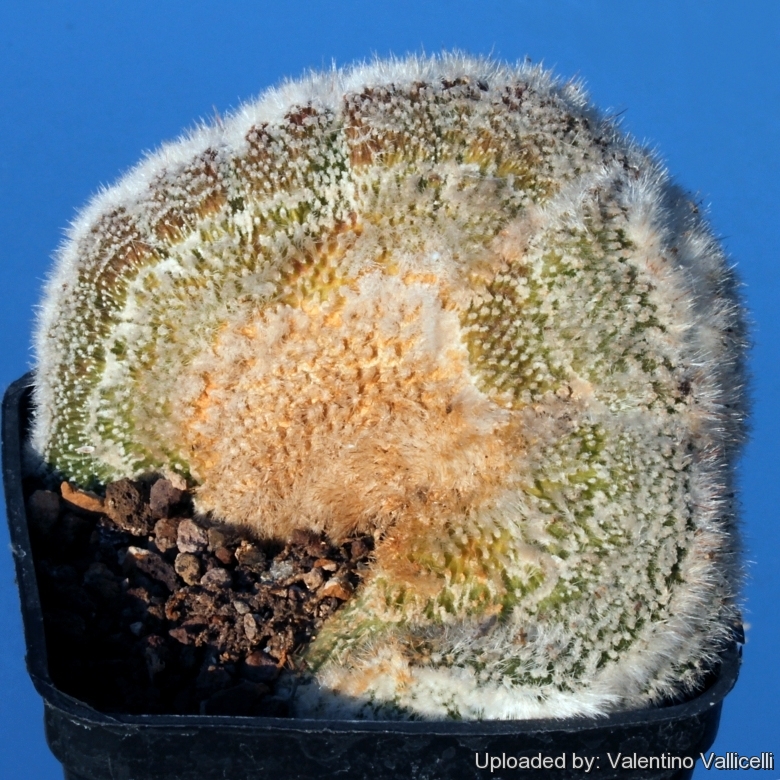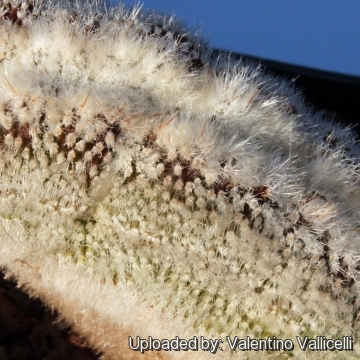Accepted Scientific Name: Parodia scopa (Spreng.) N.P.Taylor
Bradleya 5: 93. 1987

Parodia scopa f. cristata Photo by: Valentino Vallicelli
Origin and Habitat: Garden origin (Nursery produced cultivar
Synonyms:
See all synonyms of Parodia scopa
back
Accepted name in llifle Database:Parodia scopa (Spreng.) N.P.TaylorBradleya 5: 93. 1987Synonymy: 38
Accepted name in llifle Database:Parodia scopa subs. marchesii (W.R.Abraham) HofackerCactaceae Consensus Init. 6: 12. 1998Synonymy: 5
Accepted name in llifle Database:Parodia scopa subs. neobuenekeri (F.Ritter) Hofacker & P.J.BraunCactaceae Consensus Init. 6: 10. 1998Synonymy: 5
Accepted name in llifle Database:Parodia scopa subs. succinea (F.Ritter) Hofacker & P.J.BraunCactaceae Consensus Init. 6: 10. 1998Synonymy: 14
Cultivars
(2):
back
Description: Parodia scopaSN|15897]]SN|15897]] is a silvery spined cactus often clustering with showy yellow flowers. The stems are almost hidden by soft tufts of bristly white and red-brown spines somewhat similar to small brushes. The crested form Parodia scopaSN|15897]]SN|15897]] f. cristata - despite to its beauty - is very rare and sought after by collectors for its white covering of fine bristly.
Stem: Dark green, fan-shaped forming up to 5 cm thick forming with age a large white convoluted mound.
Ribs: Low, obtuse, finely notched into low warts tipped with areoles.
Areoles: White woolly.
Central spines: About 4 (but varying from 2 to 12) medium length (6-12 mm long), needle-like, stouter than radials, purple, red-brown, orangish or white.
Radial spines: Shorter, fine, bristles-like, glassy white or yellowish, 5-7 mm long, spreading around.
Flowers: A cluster of satiny, bright yellow flowers spring in the upper part of the stem forming a ring, The are 2-4 cm long and 3,5-4,5 cm in diameter. Inner perianth segments in two overlapping series, spatulate, rather wide for their length, ± toothed above, Pistil with about 10, rayed, bright crimson stigma lobes. Tube short. Scales on the ovary woolly with brown bristles.
Blooming: seson: June-July.
Fruits: Globose, about 7 mm in diameter, opening at maturity, with numerous seeds.
Seeds: Dull black tuberculate.
Subspecies, varieties, forms and cultivars of plants belonging to the Parodia scopa group
 Notocactus scopa f. cobrensis (N.Gerloff) N.Gerloff & Neduchal: has dark-red central spines and shorter white spines and wool around. It is very slow growing. Distribution: Rio Grande do Sul (Brazil)
Notocactus scopa f. cobrensis (N.Gerloff) N.Gerloff & Neduchal: has dark-red central spines and shorter white spines and wool around. It is very slow growing. Distribution: Rio Grande do Sul (Brazil) Notocactus scopa var. murielii Hofacker: has silvery spined stems. Distribution: Uruguay.
Notocactus scopa var. murielii Hofacker: has silvery spined stems. Distribution: Uruguay. Notocactus scopa f. xicoi (W.R.Abraham) N.Gerloff & Neduchal: has fewer ribs and fewer spines. Particularly striking are the numerous purple brown central spines. Distribution: Pedras Altas and Herval, Rio Grand do Sul, Brazil.
Notocactus scopa f. xicoi (W.R.Abraham) N.Gerloff & Neduchal: has fewer ribs and fewer spines. Particularly striking are the numerous purple brown central spines. Distribution: Pedras Altas and Herval, Rio Grand do Sul, Brazil. Notocactus scopa f. xiphacanthus (W.R.Abraham) N.Gerloff & Neduchal: has larger stems with fewer ribs and usually a long, dark, sword-shaped central spine. Distribution: Minas, Lavalleja, Uruguay.
Notocactus scopa f. xiphacanthus (W.R.Abraham) N.Gerloff & Neduchal: has larger stems with fewer ribs and usually a long, dark, sword-shaped central spine. Distribution: Minas, Lavalleja, Uruguay. Parodia scopa (Spreng.) N.P.Taylor: has stems with 30-40 ribs, about 4 central spines, and 40 or more radials. Distribution: Southern Brazil and Paraguay.
Parodia scopa (Spreng.) N.P.Taylor: has stems with 30-40 ribs, about 4 central spines, and 40 or more radials. Distribution: Southern Brazil and Paraguay. Parodia scopa f. cristata hort.: Crested form.
Parodia scopa f. cristata hort.: Crested form.- Parodia scopa subs. marchesii (W.R.Abraham) Hofacker: has stems with fewer ribs (19-28), 2-4 white or yellowish central spines, and about 40 radials. Distribution: Treinta y Tres, Uruguay.
- Parodia scopa subs. neobuenekeri (F.Ritter) Hofacker & P.J.Braun: stems with 18-21ribs, 6-12 strong central spines, and 30-40 radials. Distribution: near Camaqua, Rio Grande do Sul, Brazil.
 Parodia scopa f. splendens hort.
Parodia scopa f. splendens hort. Parodia scopa subs. succinea (F.Ritter) Hofacker & P.J.Braun: has stems with 18-24 ribs, 8-12 central spines, and 15-30 radials. Distribution: near Sao Gabriel, Rio Grande do Sul, Brazil.
Parodia scopa subs. succinea (F.Ritter) Hofacker & P.J.Braun: has stems with 18-24 ribs, 8-12 central spines, and 15-30 radials. Distribution: near Sao Gabriel, Rio Grande do Sul, Brazil. Parodia scopa subs. succinea f. albiseta hort.: has pure white spines.
Parodia scopa subs. succinea f. albiseta hort.: has pure white spines. Parodia scopa var. sulphurea hort.: This is only a common hoticultural name for "Parodia scopa ssp. succinea"
Parodia scopa var. sulphurea hort.: This is only a common hoticultural name for "Parodia scopa ssp. succinea" Parodia scopa cv. inermis: has spineless areoles with a short white wool, they are arranged geometrically and contrast with the stem. A few small bristly spines are occasionally produced in the flowering areoles.
Parodia scopa cv. inermis: has spineless areoles with a short white wool, they are arranged geometrically and contrast with the stem. A few small bristly spines are occasionally produced in the flowering areoles. Parodia scopa cv. inermis cristata: Crested form.
Parodia scopa cv. inermis cristata: Crested form.
Bibliography: Major references and further lectures
1) James Cullen, Sabina G. Knees, H. Suzanne Cubey “The European Garden Flora Flowering Plants: A Manual for the Identification of Plants Cultivated in Europe, Both Out-of-Doors and Under Glass” Cambridge University Press, 11/Aug./2011
2) David Hunt, Nigel Taylor “The New Cactus Lexicon” DH Books, 2006
3) Edward F. Anderson “The Cactus Family” Timber Press, 2001
 Parodia scopa f. cristata Photo by: Cactus Art
Parodia scopa f. cristata Photo by: Cactus Art Parodia scopa f. cristata Photo by: Valentino Vallicelli
Parodia scopa f. cristata Photo by: Valentino VallicelliCultivation and Propagation: Although regarded as a choice and difficult plant is not too difficult in a greenhouse, although grows quite slowly. It is sometime seen as a grafted plant but grows very well on its own roots too.
Soil: Use mineral well permeable mineral soil with little organic matter (peat, humus).
Exposure: They need a good amount of light shade to full sun this help to keep the plants healthy, although slow growth.
Watering: Water sparingly from March till October (weekly during summertime, if the weather is sunny enough) , with a little fertilizer added. Less or no water during cold winter months, or when night temperatures remain below 10° to prevent root loss. It is sensitive to overwatering (rot prone).
Fertilization: Feeding may not be necessary at all if the compost is fresh then, feed in summer only if the plant hasn't been repotted recently. Do not feed the plants from September onwards as this can cause lush growth which can be fatal during the darker cold months.
Hardiness: Keep perfectly dry in winter at temperatures from 5 to 15 degrees centigrade. (but it is relatively cold resistant and hardy to -5° C, or possibly colder for short periods) In the rest period no high atmospheric humidity!! (Temperature Zone: USDA 9-11)
Crested growth: Unlike 'monstrose' varieties of plants, where the variation from normal growth is due to genetic mutation, crested growth can occur on normal plants. Sometimes it's due to variances in light intensity, or damage, but generally the causes are unknown. A crested plant may have some areas growing normally, and a cresting plant that looks like a brain, may revert to normal growth for no apparent reason. If you have any of the crested part left you need to remove the normal growth and leave the crested part behind this will need to be done regularly.
Propagation: Grafting or cuttings. Plants are usually grafted onto column-shaped cacti but proved to be able to produce their own roots if degrafted. Cuttings will take root in a minimum temperature of 20° C (but better in hot weather). Cuttings of healthy shoots can be taken in the spring and summer. Cut the stem with a sharp, sterile knife, leave the cutting in a warm, dry place for a week or weeks (depending on how thick the cutting is) until a callus forms over the wound. Once the callus forms, the cutting may be inserted in a container filled with firmed cactus potting mix topped with a surface layer of coarse grit. They should be placed in the coarse grit only; this prevents the cut end from becoming too wet and allows the roots to penetrate the rich compost underneath. The cuttings should root in 2 to 6 weeks. Large crested piece must be placed on the soil surface without burying the plant base down in the soil.












